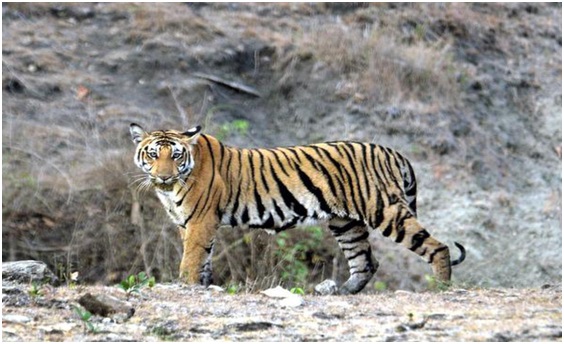MoEFCC’s U-turn to Merge Autonomous Bodies (The Hindu)

- 18 Aug 2023
Why in the News?
In June, the Ministry of Environment, Forests and Climate Change (MoEFCC) issued a notification quietly walking back on its move to establish integrated regional offices by merging offices of the Forest Survey of India (FSI), the National Tiger Conservation Authority (NTCA), the Wildlife Crime Control Bureau (WCCB), and the Central Zoo Authority (CZA), and thus bring them under the Ministry.
What's in the News?
- Amidst the Covid-19 pandemic, the central government suggested the consolidation of four entities – NTCA, CZA, WCCB, and FSI – into a single organization.
- This proposition faced intense criticism from activists who argued that it could strip key environmental bodies of their effectiveness.
- To illustrate, within the current structure, the NTCA possesses the ability to contest forest clearances for projects that involve diverting areas within Tiger Reserves.
- However, the proposed amalgamation might have complicated this process, as the NTCA would have fallen under the authority of the Deputy Director General of Forests. This individual oversees the Integrated Regional Office and reports to the Ministry of Environment, Forest and Climate Change (MoEF&CC).
About the Forest Survey of India (FSI):
- The inception of the Forest Survey of India dates back to 1981, a product of the National Commission on Agriculture's (NCA) suggestions.
- FSI conducts a biennial evaluation of the nation's forest coverage through digital analysis of satellite data from remote sensing technology. This assessment culminates in the publication of the 'State of Forest Report' (SFR).
- FSI plays an instrumental role in imparting training to forest officers from diverse Indian states.
- The base of Operations: Dehradun, Uttarakhand.
About the National Tiger Conservation Authority (NTCA):
- The National Tiger Conservation Authority, established under the Wildlife (Protection) Act of 1972, operates as a statutory body.
- Established in 2005 as a result of the recommendations of the Tiger Task Force, its core aims encompass:
- Granting legal authority to Project Tiger, thereby rendering adherence to its directives a matter of legality.
- Enhancing the accountability of both the central and state governments in managing Tiger Reserves.
- Addressing the livelihood concerns of local communities residing in the vicinity of Tiger Reserves.
- Key Responsibilities:
- Approval of tiger conservation plans devised by state governments.
- Ensuring that the integrity of tiger reserves and the ecological connectivity between different protected areas and reserves remain intact, avoiding unsustainable ecological utilization.
- Providing support and facilitation for the management of tiger reserves within states, aimed at conserving biodiversity.
- NTCA undertakes a comprehensive Tiger Census across India every four years.
- Leadership: The chairman of NTCA is the Union Minister of Environment, Forest and Climate Change.
About the Wildlife Crime Control Bureau (WCCB):
- The Wildlife Crime Control Bureau was established in 2007 as a statutory body under the Wildlife (Protection) Act of 1972.
- Main Responsibilities:
- Gathering and organizing information about organized wildlife crimes and quickly sharing it with state and other enforcement agencies to catch the criminals promptly.
- Creating a central place to store data about wildlife crimes.
- Coordinating efforts from different agencies to enforce the rules of the Act.
- Helping other countries and international groups work together to control wildlife crimes.
- Helping enforcement agencies improve their skills in investigating wildlife crimes.
- Guiding State Governments to successfully handle cases related to wildlife crimes.
- The WCCB also assists Customs authorities in checking shipments of plants and animals according to the rules of the Wildlife Protection Act, CITES, and EXIM Policy.
- The headquarters is based in New Delhi.
About the Central Zoo Authority (CZA):
- The Central Zoo Authority, established in 1992 as a legal body under the Wildlife (Protection) Act of 1972, has a specific purpose.
- What It Aims to Achieve:
- To support and enhance the national mission to conserve the diverse and valuable biodiversity of the country, especially its animals, following the guidelines of the National Zoo Policy from 1998.
- Every zoo in the nation must gain recognition from this Authority to operate.
- The Authority's main role is more about helping than controlling. It offers technical and financial assistance to zoos that have the potential to meet the desired standards in animal management.
- It sets rules and guidelines for transferring animals among zoos within the country and globally.
- It coordinates and puts into action plans for improving the skills of zoo staff, organized breeding efforts, and research done outside the natural habitat (ex-situ research).
- Headquarters: New Delhi
Why Did MoEF&CC Put Forward the Proposal?
MoEF&CC explained that the proposal was not about merging but about bringing together the different authorities to operate from 19 regional offices under one central hub.
However, in June 2023, MoEF&CC decided not to go ahead with the merger plan, possibly due to challenges in combining the involved institutions from technical and administrative standpoints.
